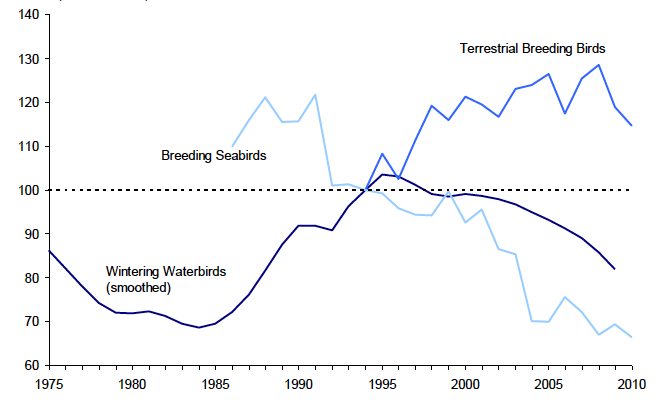Key Scottish Environment Statistics 2012
This publication aims to provide an easily accessible reference document which offers information on a wide range of environmental topics. It covers key datasets on the state of the environment in Scotland, with an emphasis on the trends over time wherever possible.
This document is part of a collection
Status of Wild Bird PopulationsR,[13],[14]: 1975-2010
Index (1994 = 100)

Bird populations are relatively well studied and can provide an indication of the state of biodiversity in Scotland's habitats.
The number of wintering waterbirds rose between the mid 1980s and mid 1990s, reaching a peak in 1995. Since then there has been a steady decline, with the abundance falling 21% between 1995 and 2009. Seabird abundance was in decline between 1991 and 2004, but has since stabilised. In 2010, the abundance of seabirds was 45% lower than the 1991 peak. The abundance of terrestrial breeding birds has shown a long term increase of 15% between 1994 and 2010; however, between 2008 and 2010 the abundance of terrestrial breeding birds decreased by 14%.
Naturally occurring birds and their habitats are protected under the Wildlife and Countryside Act 1981, the Nature Conservation (Scotland) Act 2004 and the EC Birds Directive (79/409/EEC and amendments). Actions to protect and enhance bird populations and habitats are coordinated under the Scottish Biodiversity Strategy.
The Scottish Government has established a National Indicator to increase the index of abundance of terrestrial breeding birds in Scotland against a 2006 base year. This is used as a proxy measure of biodiversity, as biodiversity cannot be measured by a single indicator.
Source: British Trust For Ornithology / Joint Nature Conservation Committee / Wildfowl And Wetlands Trust / Metadata
Contact
Email: Sandy McPhee
There is a problem
Thanks for your feedback